| The
seventh century A. D. is considered as a landmark in the history
of Buddhism in Tibet. Through the introduction of Buddhism into
the land it witnessed a social and cultural advance. From the
seventh century onwards while extensive literary activity in
terms of translation from Sanskrit to Tibetan and composition
of Tibetan literature was in progress, a corresponding development
in art also took place. Many beautiful monasteries and temples
decorated with frescos and paintings, cast images and ritual
objects, were set up.
Tibet
in those days was open to foreign influences. It had continuous
contact with India, Nepal, China and the countries of Central
Asia, and hence was well disposed to receive all forms of art
and culture.
Hence,
there can be no doubt that the first artists who painted frescos
and modelled the figures of gods and goddesses of the Tibetan
Buddhist pantheon, were not Tibetan, but Indians, Nepalese and
Chinese. This is indicated by the account given of the construction
of the monastery bSam-yas according to which the lower part
was done in the Tibetan manner, the middle with a Chinese roof
and the upper part with an Indian roof. The same tradition also
claims that a castle built south-east of bSam-yas had nine turrets
and three floors: the ground floor, Tibetan; the two-roofed
first floor was built in the style of Khotan, the second in
Chinese style and the third in the Indian style.1
Foremost
among this influx of artistic culture from abroad was the importation
of art forms and styles from India. From the seventh century
onwards for several hundred years, cultural relations between
India and Tibet were at their peak. It was during these centuries
that countless Buddhist monks and their associates, including
artists and craftsmen, must have gone to Tibet and Nepal carrying
manuscripts, paintings and small portable icons in metal and
stone. These images and paintings probably served to illustrate
the preaching of the Dharma and they constituted the most important
examples of Buddhist iconography. Moreover, the images and the
illustrative materials served as models and inspiration for
the artistic development in the country. On the other hand,
many enthusiastic Tibetan monks undertook strenuous journeys
to India in search of knowledge in the field of religion as
well as in other secular subjects like medicine, logic, grammar,
astrology, and art. In the course of time, they mastered Buddhist
art, went back to their homeland to apply their newly acquired
knowledge in the field of art.
The
Indian styles which had a profound influence upon the early
development of Tibetan Buddhist art, were notably those of Gandhara,
Kashmir and Bengal. The styles of Gandhara and Kashmir distinguished
by Hellenistic motifs such as the Corinthian type of pillar
capital, the frequent occurrence of the Midas theme and the
use of elaborate floral and other motifs for filling up empty
spaces in murals and frescos found ready acceptance in the school
of Gu-ge centred in the west of Tibet. Concrete evidence of
the movement of these stylistic elements from Kashmir to Tibet
is provided by the murals at Alchi in Ladakh which are said
to have been executed by artists who accompanied the translator
Rin-chen-bzan-po on his return to Tibet from Kashmir.2
The
Pala style of Bengal characterised by the lightness of figures
and delicacy of treatment found its way to Tibet via Nepal.
These stylistic elements along with the richly ornamented thrones
and halos characteristic of Nepalese art are common in the Beri
school which became prominent in southern Tibet.
In
the development of Tibetan art, Nepal played a significant role.
Nepal acted as a meeting place between India on the one hand
and Tibet and China on the other. Nepal, by accepting the art
and iconography of Indian Buddhism together with its theory
and technique, rendered a great service to the growth of Tibetan
Buddhist art. The matrimonial alliance between Tibet and Nepal
concluded in the seventh century brought these two countries
into close contact. The Nepalese princess is said to have brought
to Tibet the images of Aksobhya,
Maitreya
and Tara.3
The images and paintings of Nepal definitely served as a source
of inspiration which developed the conception of aesthetic beauty
in the minds of the Tibetans.
The
art of Nepal continued to play a role in Tibet even much later
through the activities of skilled Nepalese artists. At the instance
of Kublai Khan, a wonderful artist from Nepal skilled in both
stone and metallic executions, named Aniko, with his eighty
companions, were invited by the abbot of Sakya, Chos-gyal
Phags-pa, to erect a golden stupa in Tibet.4
It is said that Aniko with his assistants decorated the monasteries
of Tibet and China. The style of Aniko became the guideline
for the Imperial Chinese art. The Nepalese influence can be
traced in those Tibetan Buddhist icons and paintings in which
we notice an increasing hieratic stylization of forms. The figures
become more and more loaded with a profusion of jewellery and
ornamentation. The Pala art of Bengal continued to develop in
Nepal which in its turn contributed its stylized version to
the development of Tibetan Buddhist art.
Beside
this Indo-Nepalese influence from the South, Tibet was also
in touch with the countries of Central Asia including Chinese
Turkistan. The destruction of Buddhist communities in Central
Asia by the Muslims forced Buddhist monks to take shelter in
the monasteries of Tibet. The various protectors of the Dharma
with their warlike following all clad in armour and typical
Central Asian attire in Tibetan Buddhist art can be considered
an importation from the North.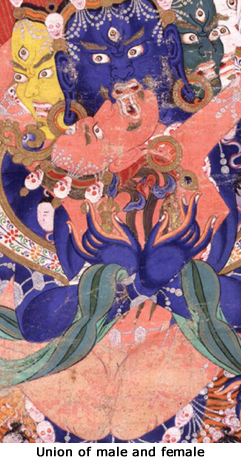
The
first influence of Chinese art from the Tang period became evident
as the result of the friendly - relations with China sealed
by the wedding of Sron-btsan-sgam-po
with the Chinese princess.
When
the foundations of Tibetan Buddhist art were being created,
certain influences were left by the temporary Tibetan rule in
the ninth century over Chinese Turkistan and the oasis of Tunhuang
in Kansu province famous for its rock temples. Again, in the
seventeenth and eighteenth centuries, Chinese art exercised
a considerable influence over Tibetan art causing sudden changes
in the old traditions mainly in painting and architecture. New
monasteries were founded and old ones renovated.5
The
Chinese element in Tibetan art can be seen in the openness of
backgrounds, the use of
landscapes and the figures of animals and the diagonal action
of the figures as well as in the use of delicate pastels.
The
primary symbols which are to be found in Tibetan Buddhist Tantric
iconography range from those of universal and archetypal character
to those which may be referred to a limited cultural context.
Among the former we may count such symbols as the union of male
and female so prevalent in Tantric iconography and the image
of the tree
of enlightenment. These symbols are clearly not restricted to
any particular culture and have appeared many times in a variety
of religious and literary contexts.
In
addition, there are numerous symbols which are drawn from the
Indian mythological heritage and which are adopted and modified
to express Tantric concepts. Among these, perhaps the most notable
are the Vajra and the Padma.
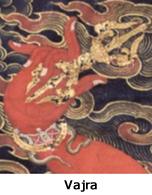 The
Vajra, initially well-known as the sceptre of Indra, expressed
his mastery over the world. It came to assume tremendous importance
in Tantric philosophy and symbolism. While the original symbolic
significance remained relevant, because the Vajra wielded by
Buddhist Tantric dieties may be taken as expressing their mastery
over the world of existence, the Vajra came to symbolize a great
deal more in Buddhist iconography. It seems the primary significance
of the Vajra in Buddhist Tantric thought is as a symbol of the
indestructible nature of the ultimate truth. In this sense,
the term Vajra is often explained as synonymous with emptiness
(sunyata) which is indestructible.6
The Vajra is said to be superior to all things in that while
it is capable of destroying anything with which it comes into
contact, it, like a diamond, remains unaffected. It may well
be that this explanation of the significance of the term Vajra
led to the employment of the term Vajrayana as designation of
Tantric Buddhism in general. The connection may become clearer
if it is recalled that through Tantric methodology situations
and emotions normally injurious to spiritual progress can be
appropriated and turned to a religious purpose without in any
way adversely affecting the Tantric practitioner. Again, in
other contexts such as when it is found in association with
the Vajraghanta as in the case of Vajra-sattva, the Vajra represents
skilful means, the active component of the ultimate attainment
of Buddhahood, while the Vajra-ghanta or bell represents wisdom. The
Vajra, initially well-known as the sceptre of Indra, expressed
his mastery over the world. It came to assume tremendous importance
in Tantric philosophy and symbolism. While the original symbolic
significance remained relevant, because the Vajra wielded by
Buddhist Tantric dieties may be taken as expressing their mastery
over the world of existence, the Vajra came to symbolize a great
deal more in Buddhist iconography. It seems the primary significance
of the Vajra in Buddhist Tantric thought is as a symbol of the
indestructible nature of the ultimate truth. In this sense,
the term Vajra is often explained as synonymous with emptiness
(sunyata) which is indestructible.6
The Vajra is said to be superior to all things in that while
it is capable of destroying anything with which it comes into
contact, it, like a diamond, remains unaffected. It may well
be that this explanation of the significance of the term Vajra
led to the employment of the term Vajrayana as designation of
Tantric Buddhism in general. The connection may become clearer
if it is recalled that through Tantric methodology situations
and emotions normally injurious to spiritual progress can be
appropriated and turned to a religious purpose without in any
way adversely affecting the Tantric practitioner. Again, in
other contexts such as when it is found in association with
the Vajraghanta as in the case of Vajra-sattva, the Vajra represents
skilful means, the active component of the ultimate attainment
of Buddhahood, while the Vajra-ghanta or bell represents wisdom.
While
the significance of the Vajra underwent extensive development
and modification within the Buddhist Tantric  tradition,
the significance of the Padma or lotus seems to have remained
largely unaltered. The symbol of the Padma commonly found in
Indian spiritual iconography as representing the transformation
from an impure condition to a pure one which is the goal of
spiritual discipline, retained by and large the same significance
in Buddhist Tantric iconography. The Padma which is born in
the mud nonetheless rises above it and unfolds the flower of
spiritual excellence. The fact that nearly all Buddhist Tantric
deities of any consequence are pictured seated upon lotus thrones
indicates the purified condition of their being. tradition,
the significance of the Padma or lotus seems to have remained
largely unaltered. The symbol of the Padma commonly found in
Indian spiritual iconography as representing the transformation
from an impure condition to a pure one which is the goal of
spiritual discipline, retained by and large the same significance
in Buddhist Tantric iconography. The Padma which is born in
the mud nonetheless rises above it and unfolds the flower of
spiritual excellence. The fact that nearly all Buddhist Tantric
deities of any consequence are pictured seated upon lotus thrones
indicates the purified condition of their being.
Another
symbol which is often met with in both Mahayana and Tantric
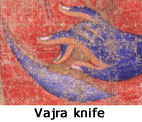 iconography
is that of the sword or Vajra knife. The sword is best known
in Mahayana iconography as the weapon of the Bodhisattva Manjusri.
This Bodhisattva is usually pictured holding the sword in the
right hand and a holy text in the left. The sword is a symbol
of the wisdom of discrimination which cuts through the net of
erroneous views and ignorance while the text of the Perfection
of Wisdom represents the purified knowledge which replaces the
mistaken notions of the ego and the like which are responsible
for the presence of suffering. iconography
is that of the sword or Vajra knife. The sword is best known
in Mahayana iconography as the weapon of the Bodhisattva Manjusri.
This Bodhisattva is usually pictured holding the sword in the
right hand and a holy text in the left. The sword is a symbol
of the wisdom of discrimination which cuts through the net of
erroneous views and ignorance while the text of the Perfection
of Wisdom represents the purified knowledge which replaces the
mistaken notions of the ego and the like which are responsible
for the presence of suffering.
The
Vajra knife which is characteristic of Tantric iconography possesses
essentially the same significance as the sword. Such curved
knives are found wielded by large numbers of Tantric deities,
both major and minor. Vajrayogini holds such a knife as does
Mahakala in some representations.
Moreover,
the many ornaments which adorn the figures of Tantric deities
have a wide range of significance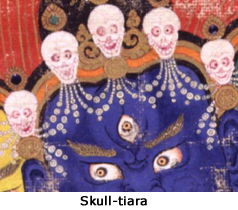 ,
both general and specific. Professor Tucci has discussed exhaustively
the role played by the symbolism of royalty in Tantric iconography
as represented by the conception of the celestial mansion and
certain specific ornaments such as the crown which adorn the
head of Ratnasambhava.7 The
bone ornaments which are very striking features of Tantric iconography
as well as the garments of animal skins and the like can be
said to parallel the costumes of demons of Indian mythology.
Their assumption by the deities of the Buddhist Tantric pantheon
represents the defeat of the demonic forces by the Tantric deities.
Further, the symbolism of demonic costumes serves to reinforce
the Tantric conception that obstacles and passions may be transformed
and so used for spiritual ends. ,
both general and specific. Professor Tucci has discussed exhaustively
the role played by the symbolism of royalty in Tantric iconography
as represented by the conception of the celestial mansion and
certain specific ornaments such as the crown which adorn the
head of Ratnasambhava.7 The
bone ornaments which are very striking features of Tantric iconography
as well as the garments of animal skins and the like can be
said to parallel the costumes of demons of Indian mythology.
Their assumption by the deities of the Buddhist Tantric pantheon
represents the defeat of the demonic forces by the Tantric deities.
Further, the symbolism of demonic costumes serves to reinforce
the Tantric conception that obstacles and passions may be transformed
and so used for spiritual ends.
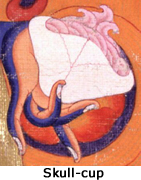 This
is not to say, however, that the complicated adornments which
decorate the figures of Tantric deities have only a general
and amorphous significance. They also admit of specific interpretations,
as expressing elements of Buddhist and Tantric philosophy. While
skull cups and ornaments of bone obviously express the consciousness
of impermanence which is so fundamental to Buddhist thought,
they have more specific references as well. For instance, the
crowns of five skulls which adorn the heads of a large number
of Tantric deities are explained in commentaries as representing
the five transcendent wisdoms 8
associated with the five Dhyani Buddhas. Again, the six
ornaments of bone, i.e.the skull-tiara, the armlets, the bracelets,
the anklets, the bone-bead apron This
is not to say, however, that the complicated adornments which
decorate the figures of Tantric deities have only a general
and amorphous significance. They also admit of specific interpretations,
as expressing elements of Buddhist and Tantric philosophy. While
skull cups and ornaments of bone obviously express the consciousness
of impermanence which is so fundamental to Buddhist thought,
they have more specific references as well. For instance, the
crowns of five skulls which adorn the heads of a large number
of Tantric deities are explained in commentaries as representing
the five transcendent wisdoms 8
associated with the five Dhyani Buddhas. Again, the six
ornaments of bone, i.e.the skull-tiara, the armlets, the bracelets,
the anklets, the bone-bead apron 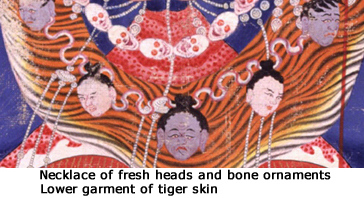 and
waist-band combined with the double line of bone beads extending
over the shoulders onto the breast which adorn important Tantric
deities are explained as representations of the six perfections:
generosity, morality, patience, energy, concentration, and wisdom. and
waist-band combined with the double line of bone beads extending
over the shoulders onto the breast which adorn important Tantric
deities are explained as representations of the six perfections:
generosity, morality, patience, energy, concentration, and wisdom.
In
a survey of the symbols of Tantric iconography, one cannot overlook
the significance of the colours employed in thankas and murals.
Five primary colours are associated with the five Buddhas of
the basic mandala. Thus, they represent symbolically the quality
associated with each of the five Buddhas.
For
example, the Ratna family of Ratnasambhava
is associated with the element of earth and the defilement of
pride. The defilement of pride in its purified aspect takes
the form of transcendental wisdom of equality. The colour of
this family is yellow, the colour of earth. Yellow functions
as a symbol of putrescent pride while alternatively it symbolizes
the richness of gold which expresses the all-embracing equanimity
of transcendental wisdom.
The
Padma family of Amitabha
is associated with the defilement of passion and the element
of fire. In its impure state passion seeks to consume like fire
everything with which it comes into contact. In its purified
state, it is the transcendental wisdom of discrimination which
appreciates and apprehends precisely all situations with compassion.
The colour associated with this family is red. The brillance
and heat of red symbolizes passion which excludes everything
in its fascination with the object of desire. Alternatively,
the vividness and the brilliance of red symbolizes the all-embracing
compassion of the transcendental wisdom of discrimination.
In
addition, we find that many of the Tantric deities are black
in colour. Black symbolizes immutability, i.e. the quality of
remaining unaffected and impervious to any external influences.
Thus black symbolizes the inconquerable and secure nature of
the accomplished state.
The
mounts or asanas upon which the Tantric deities are pictured
also have important philosophical 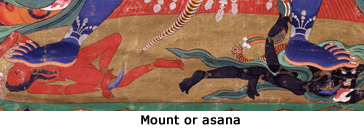 significance.
Thus it is that the corpse upon which Mahakala stands in some
representations is said to symbolize the ego and the triumph
of the deity over it. Yamantaka, the wrathful emanation of Manjusri
tramples upon the head of Yama which expresses his triumph over
death. Again, Vajrakila
is depicted trampling upon Siva and Uma who in this case symbolizes
his triumph over the extremes of eternalism and nihilism. significance.
Thus it is that the corpse upon which Mahakala stands in some
representations is said to symbolize the ego and the triumph
of the deity over it. Yamantaka, the wrathful emanation of Manjusri
tramples upon the head of Yama which expresses his triumph over
death. Again, Vajrakila
is depicted trampling upon Siva and Uma who in this case symbolizes
his triumph over the extremes of eternalism and nihilism.
The
objects which the various Tantric deities hold in their hands
also have specific significance. Vajrayogini,
for instance, holds in her right hand a vajra knife which symbolizes
the cutting off of naive ignorance. In her left hand, she holds
a skull cup filled with blood from which she drinks. This symbolizes
her consumption of the defilements which give rise to suffering.
Thus
the detailed description of the Tantric deities including colour,
ornaments, hand objects and mount found in the appropriate texts
and represented in paintings and images is capable of individual
and specific interpretation of all its elements. Therefore,
it is evident that the intricate symbolism of Buddhist Tantric
iconography includes a wide variety of symbols drawn from a
number of sources. The interpretations of the significance of
Tantric symbolism is all the more difficult, because the symbols
may be interpreted on a variety of levels which makes it impossible
to fix upon any one interpretation as exclusively correct. Nonetheless,
far from being a haphazard conglomeration of horrific forms
and macabre paraphernalia, Tantric iconography is a carefully
constructed system of psychological symbolism calculated to
express succinctly and pictorially the whole of Buddhist religion
and Tantric philosophy. It functions as skilful means by which
the Tantric adept is assisted in his appropriation and realization
of the divine vision. Thus, Tantric iconography is an integral
part of the process of liberation and enlightenment.
NOTES
1.
Steine, R. A., Tibetan Civilization, London, 1972, p. 283. [back]
2.
Gu-ge-Khri-tan ye-ses-dpal, Collected Biographical Material
About Lo-chen-Rin-chen-bzari-po and his Subsequent Reembodiments,
pp. 51 - 128. [back]
3.
Obermiller, E., History of Buddhism, Heidelberg 1931, p. 184
and Chattopadhyaya, A., Atisa and Tibet, Calcutta, India, 1967,
p. 186. [back]
4.
Ray, A., Art of Nepal, New Delhi, India, 1973. p.9. [back]
5.
Jisl, Lumir, Tibetan Art, p. 12. [back]
6.
Bhattacharyya, B., An Introduction -to Indian Buddhist Iconography,
Calcutta, India, 1968, Introduction. [back]
7.
Tucci, G., Theory and Practice of the Mandala, Roma, 1949, pp.
44 - 45. [back]
8.
Ibid., p. 70. [back]
-----by
the Same Author
1) The
Vajrayana: Myth and Symbolism
2) The
Tree of Enlightenment: An Introduction to the Major Traditions
of Buddhism
|
